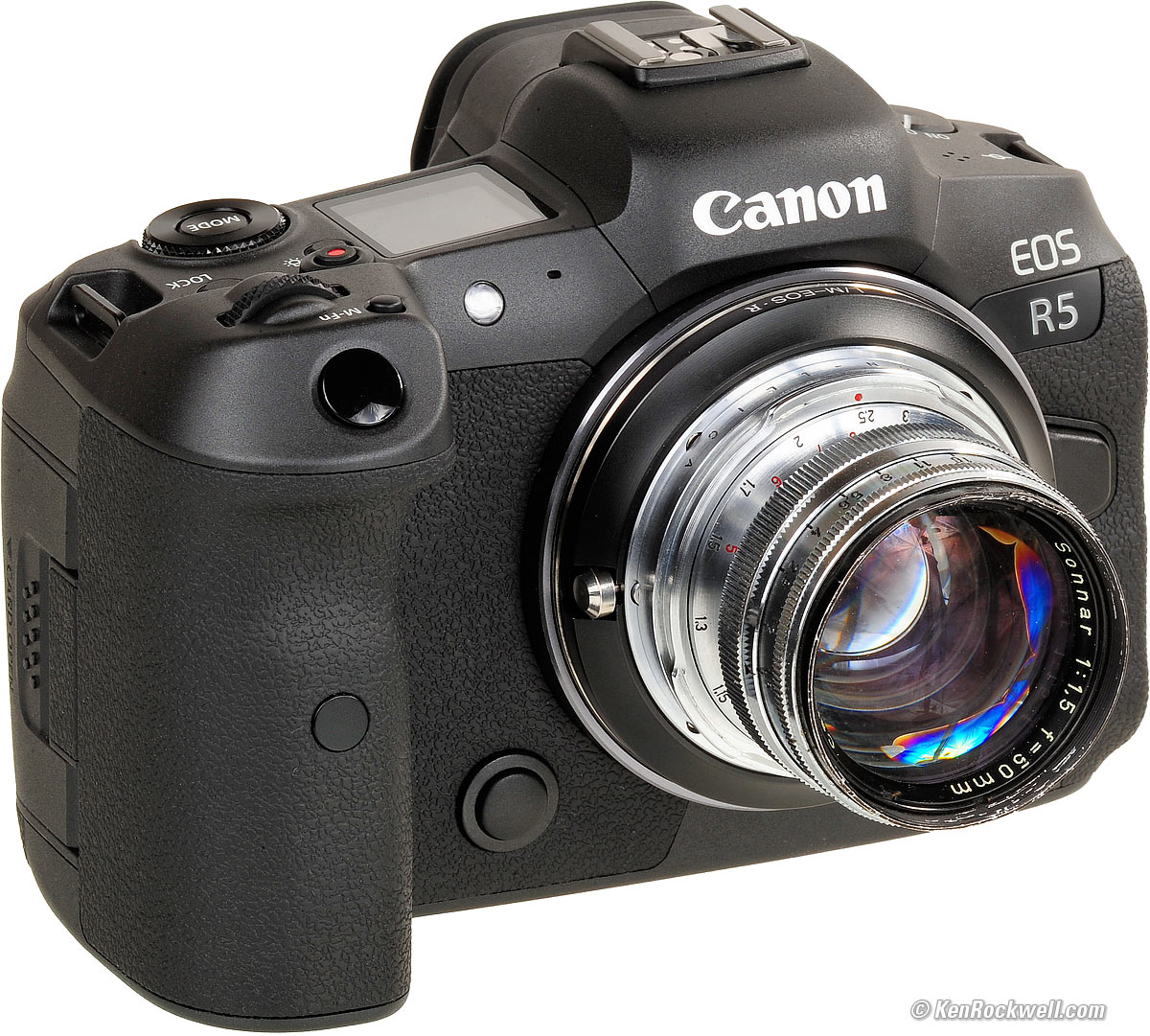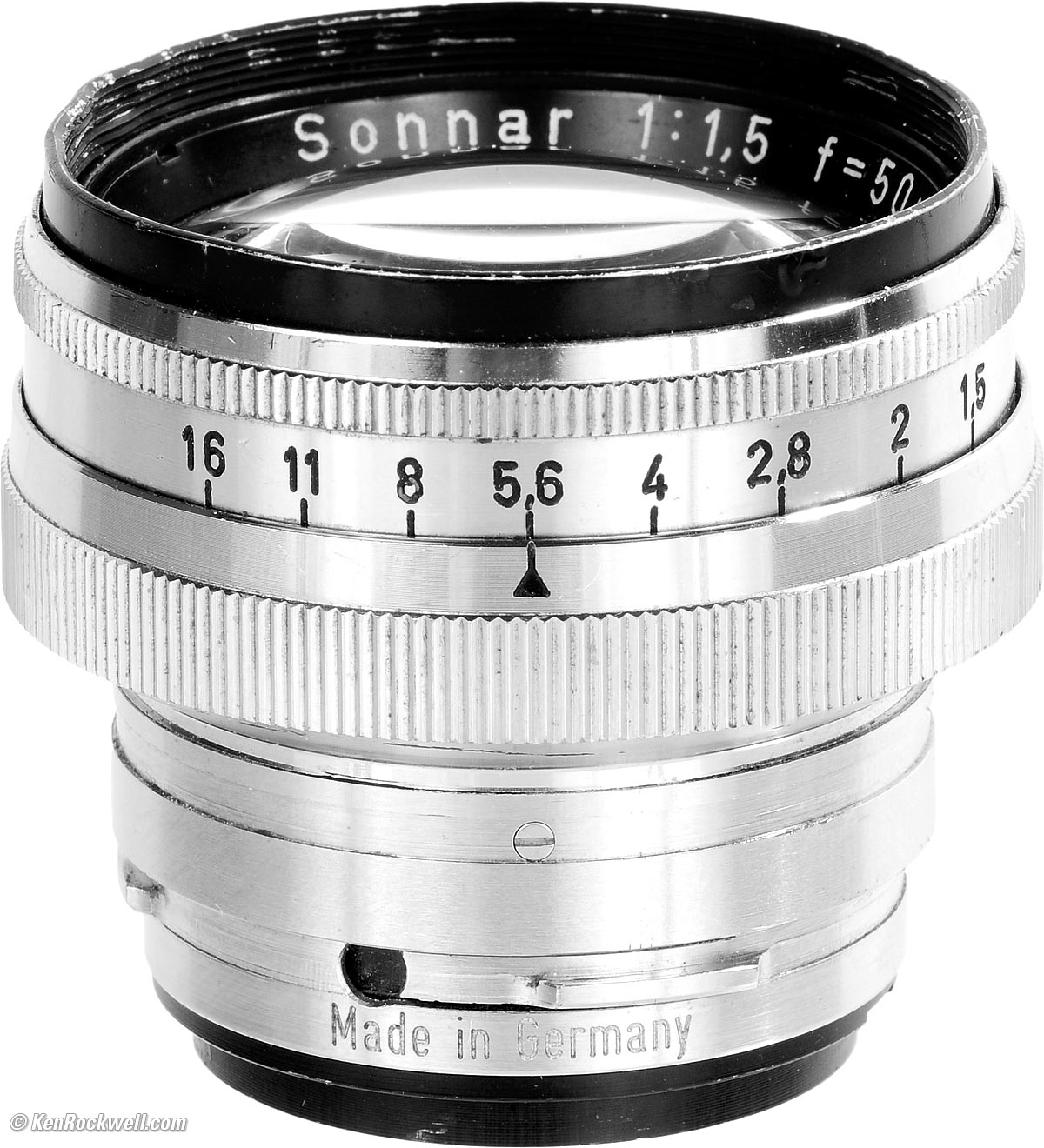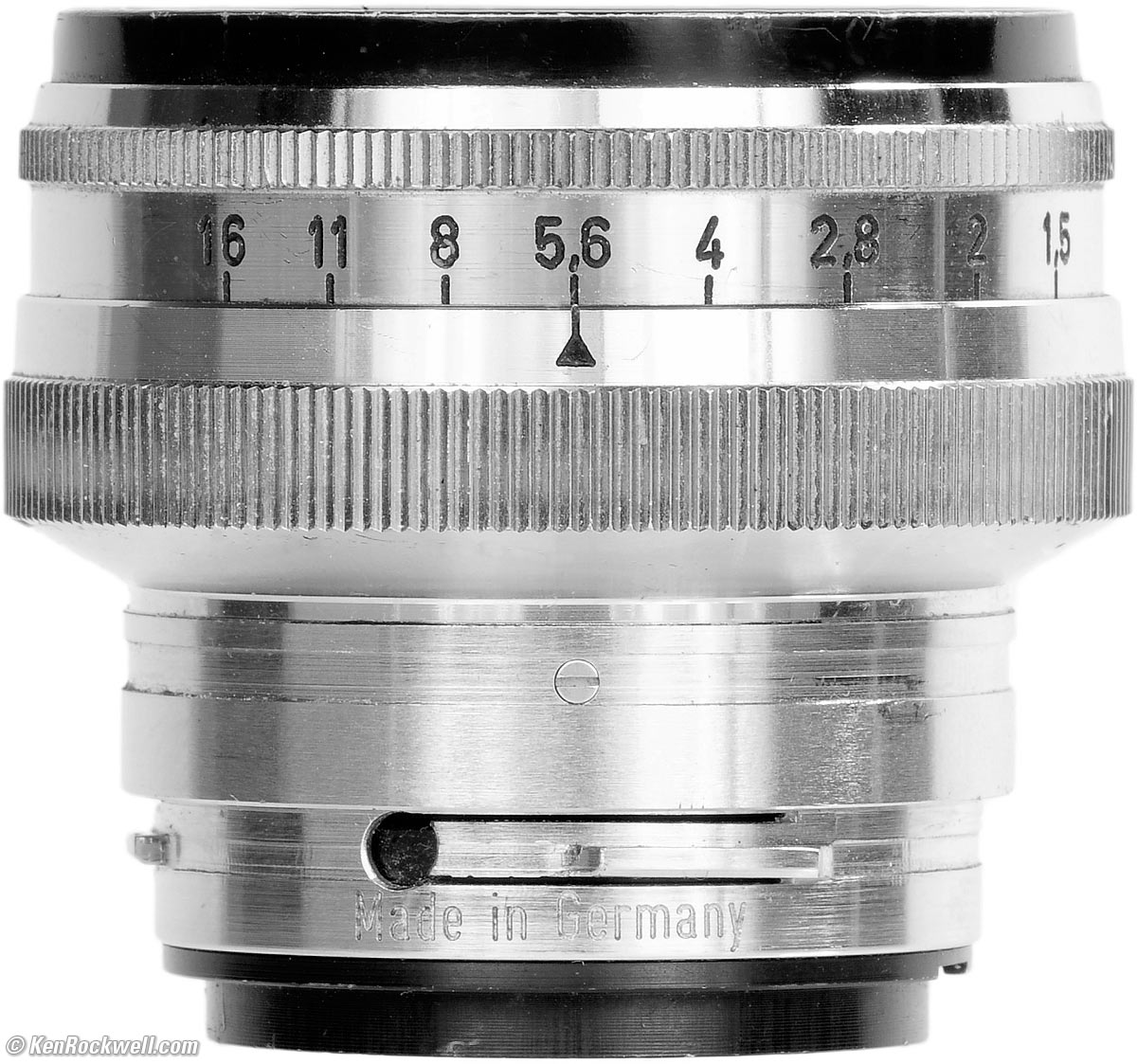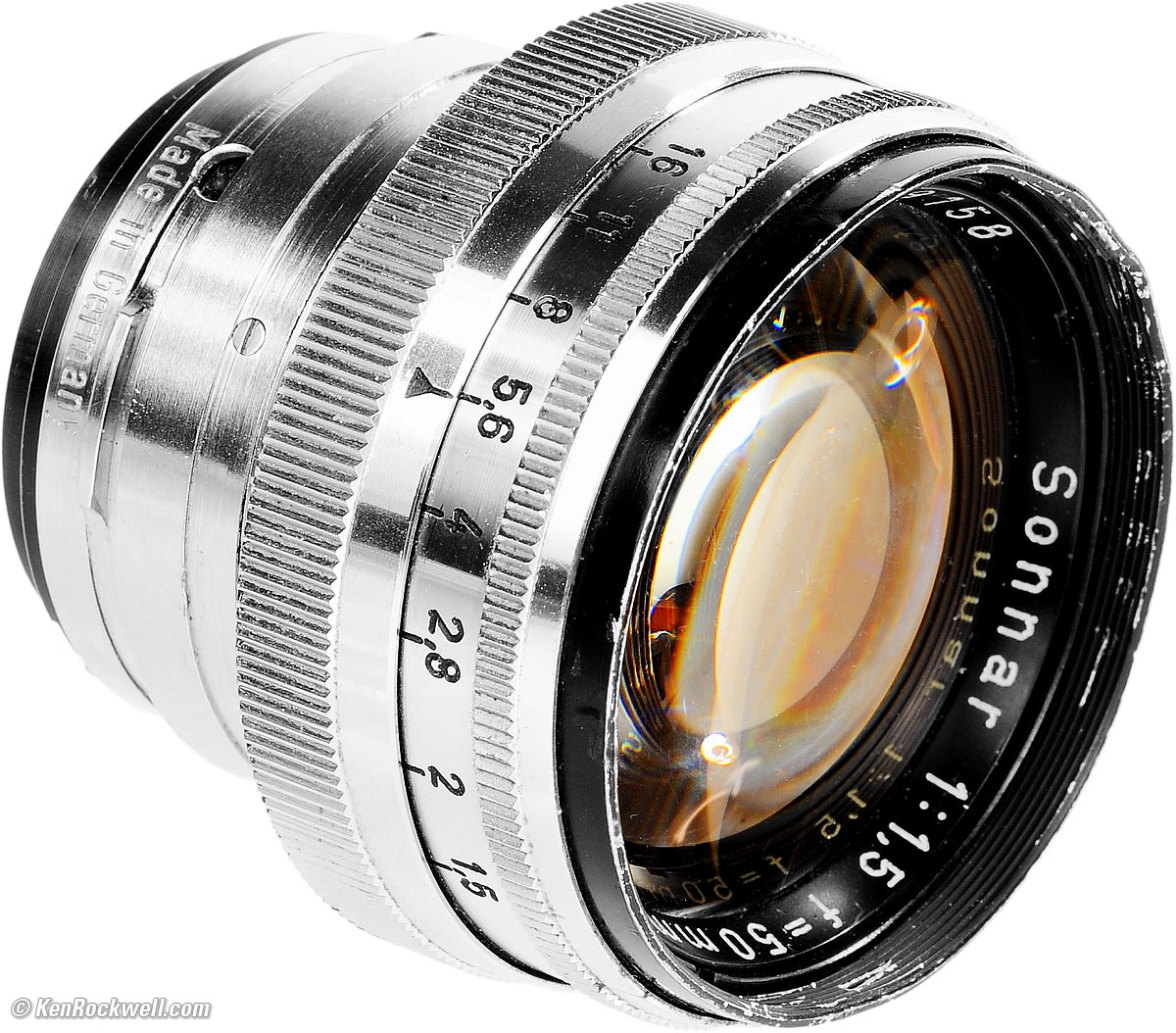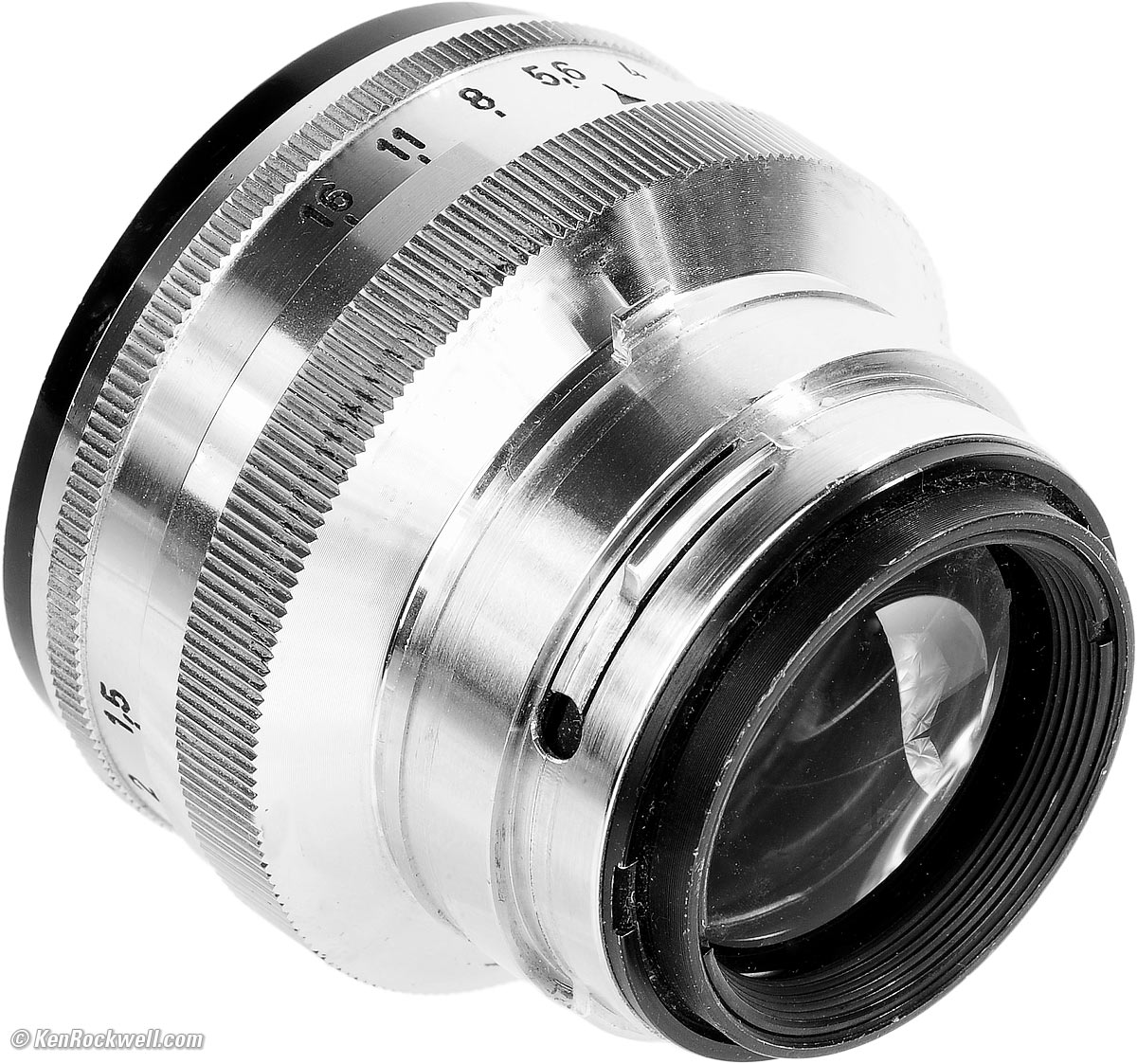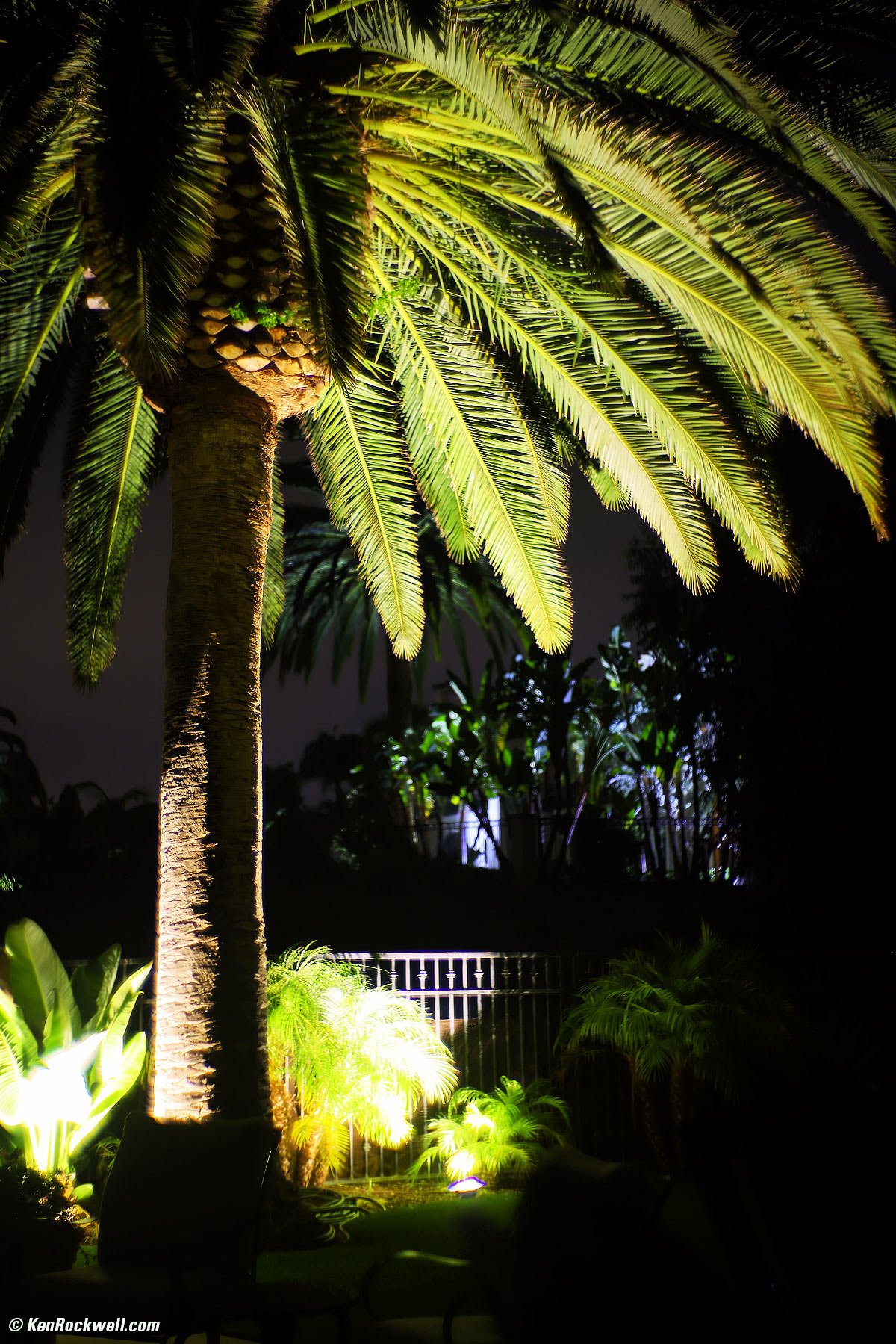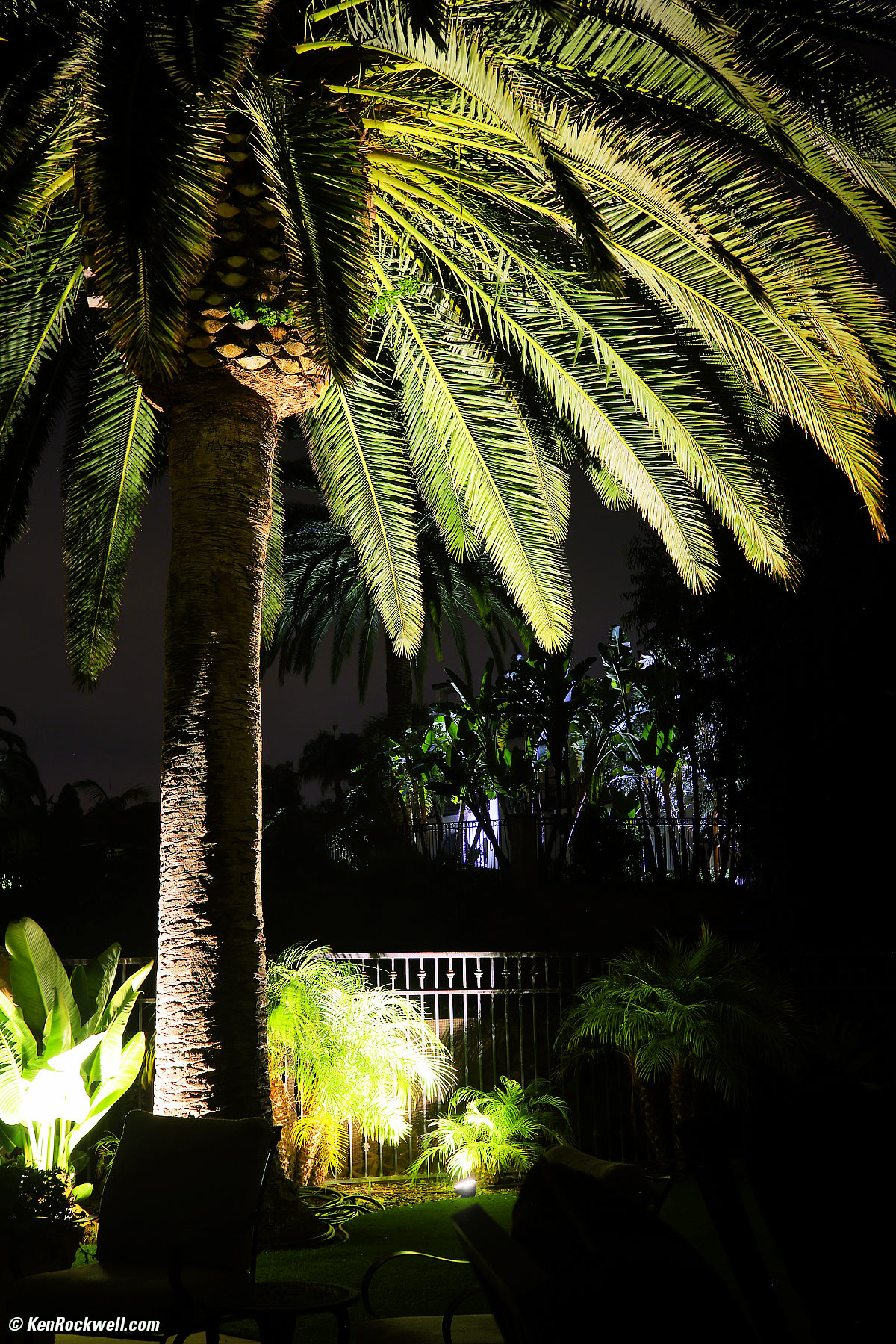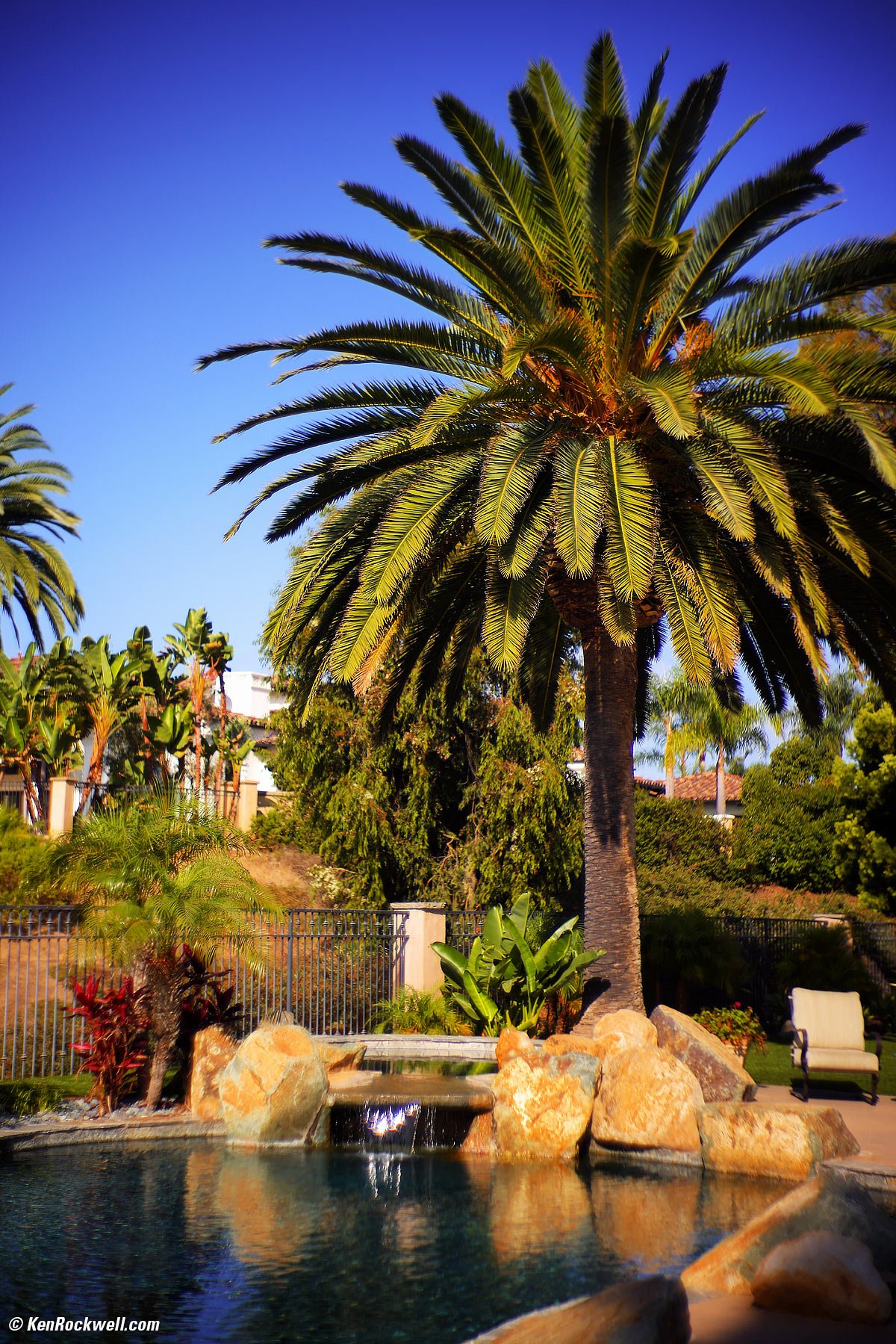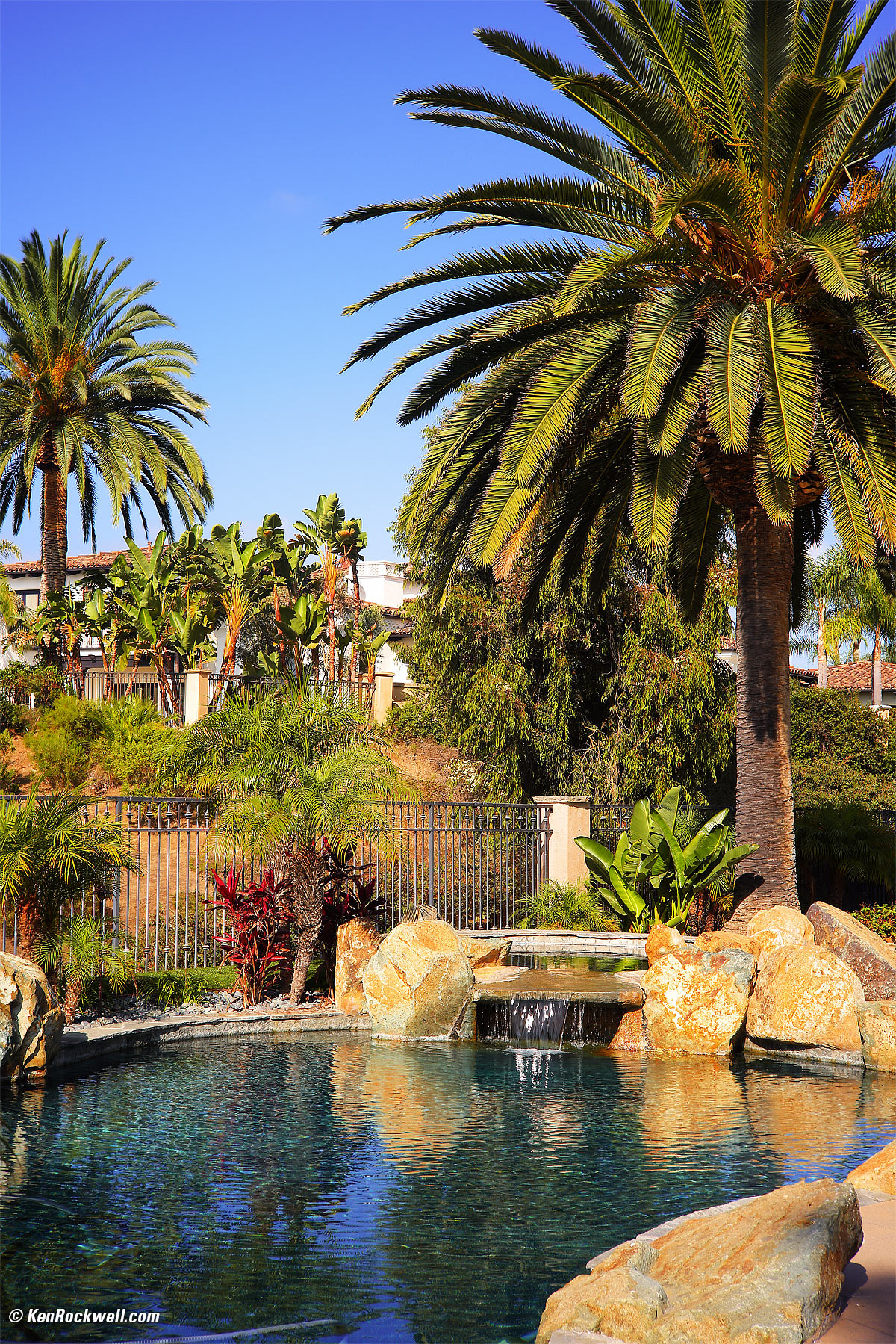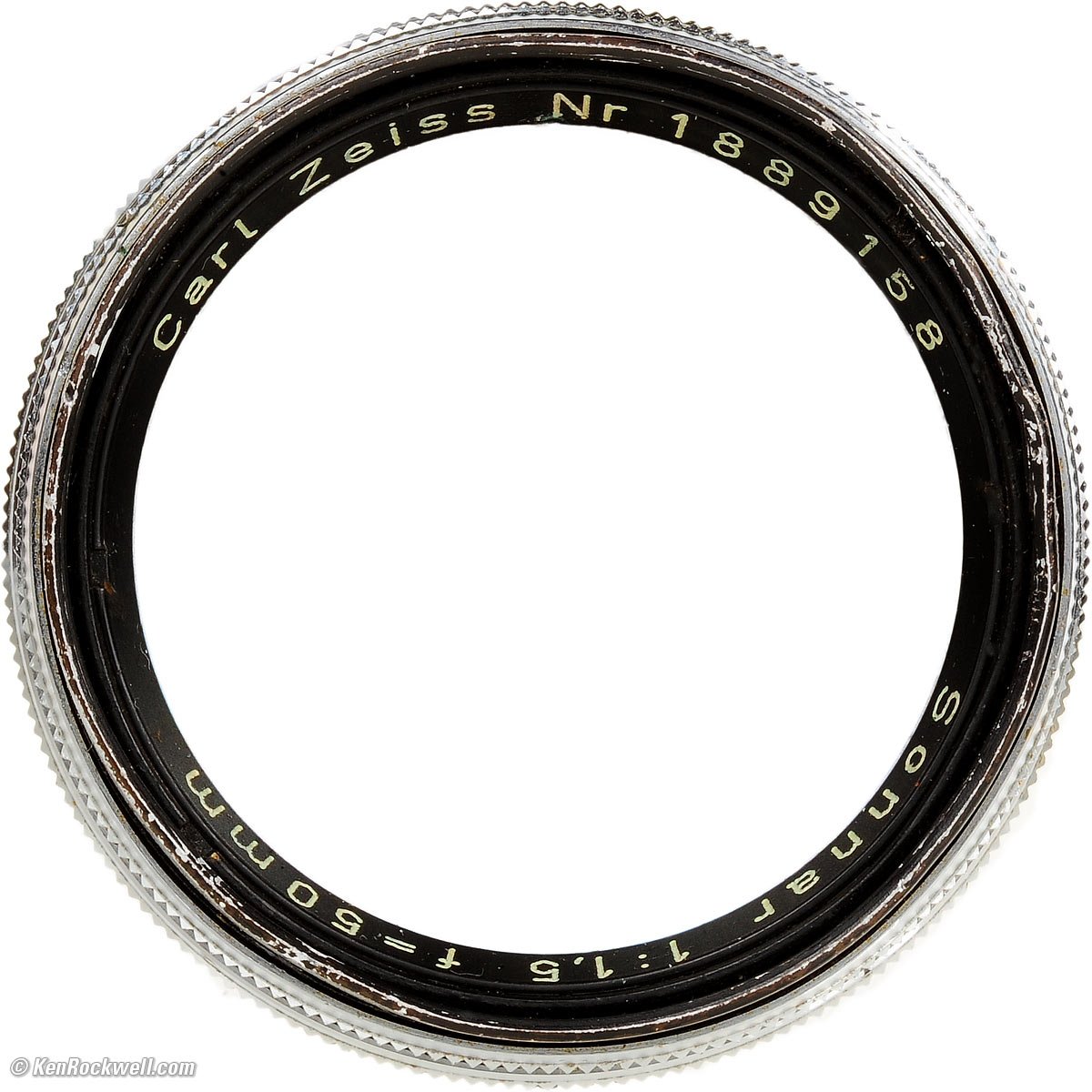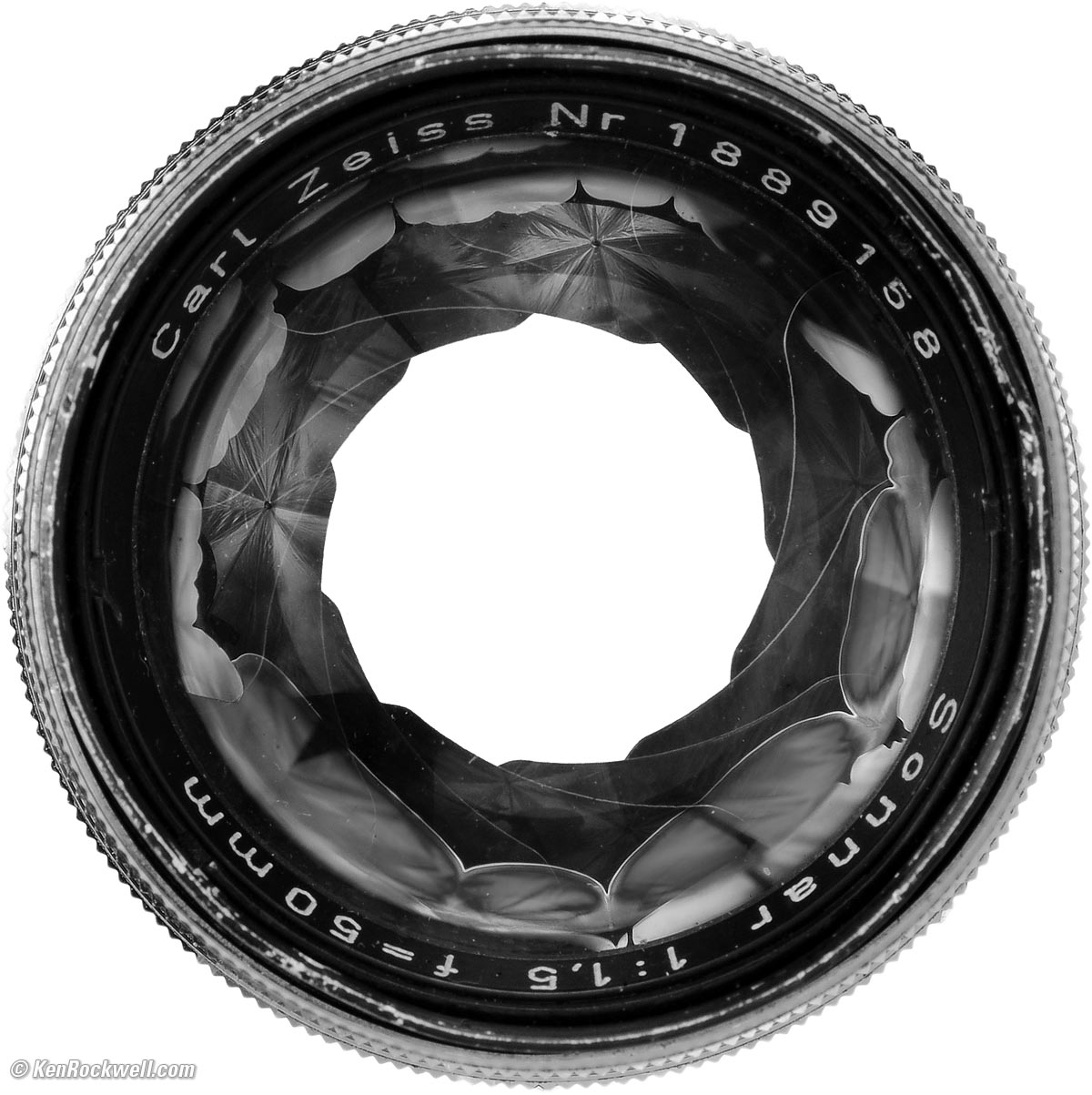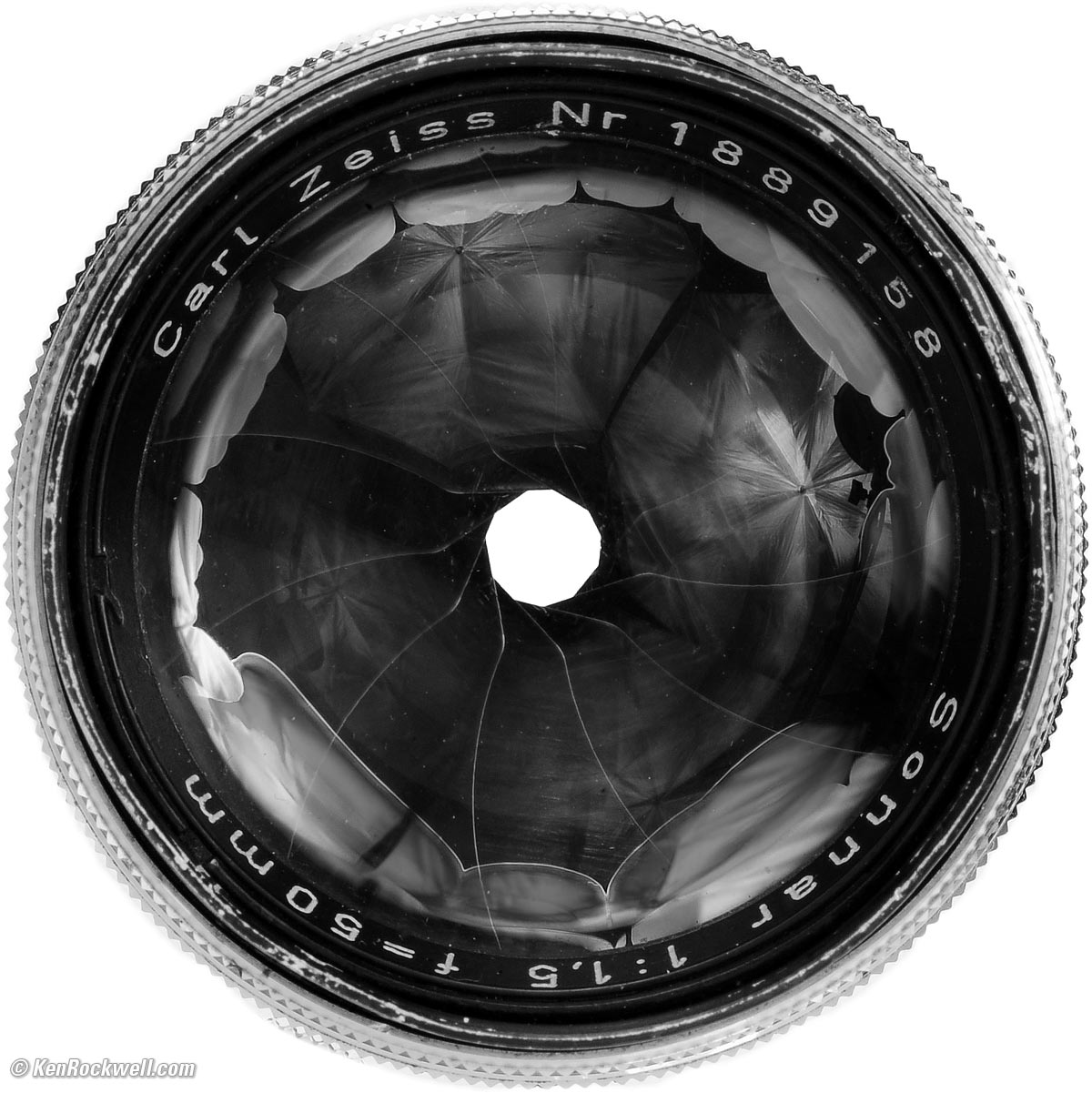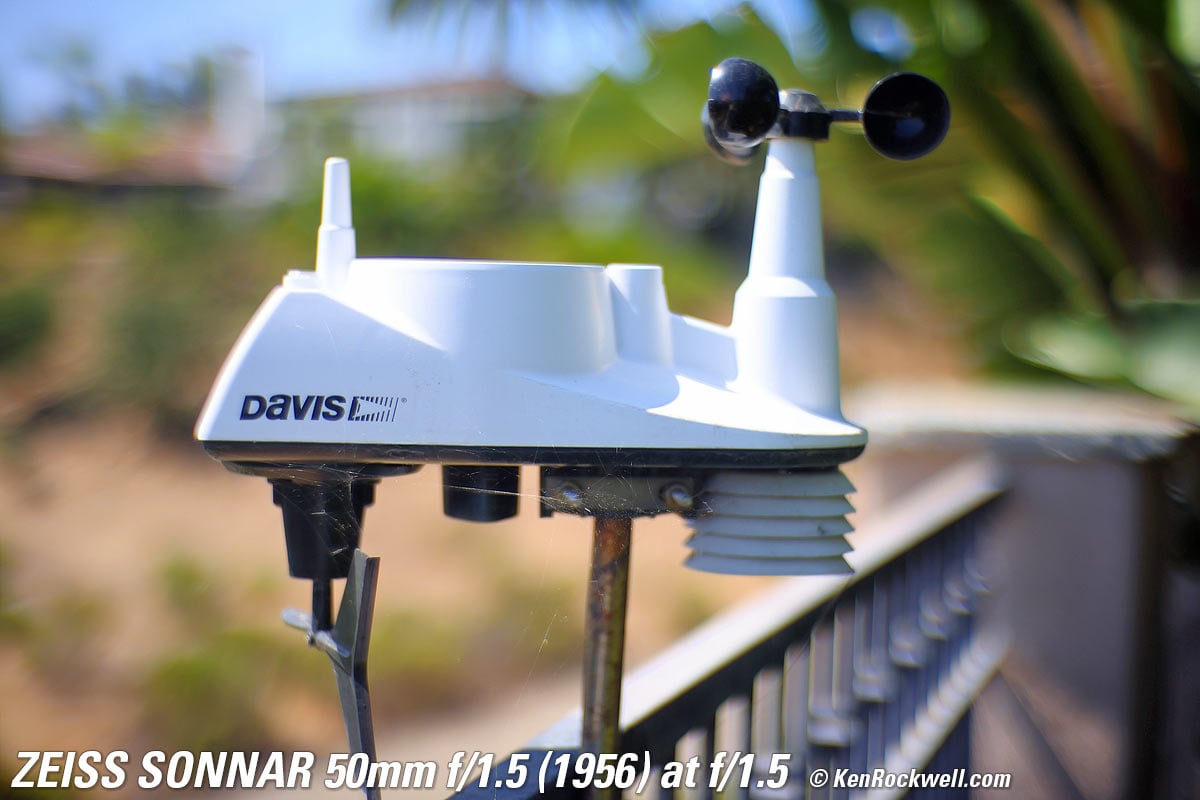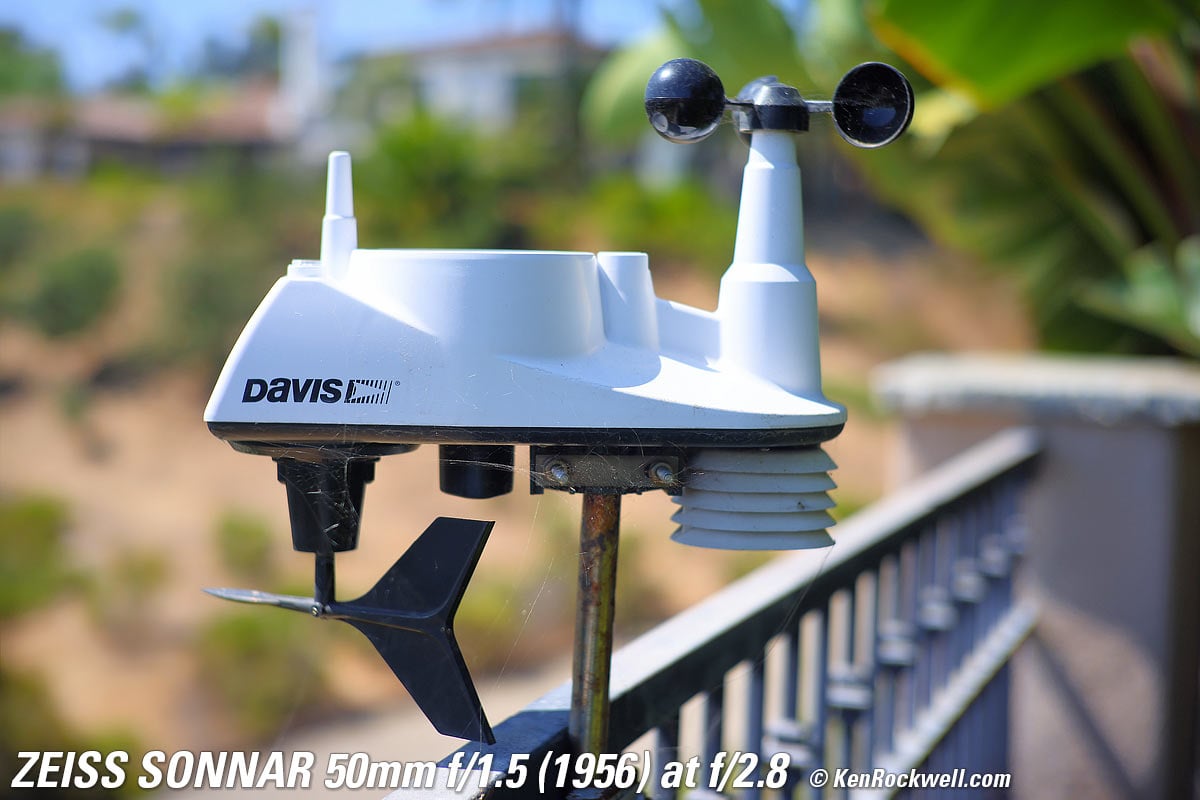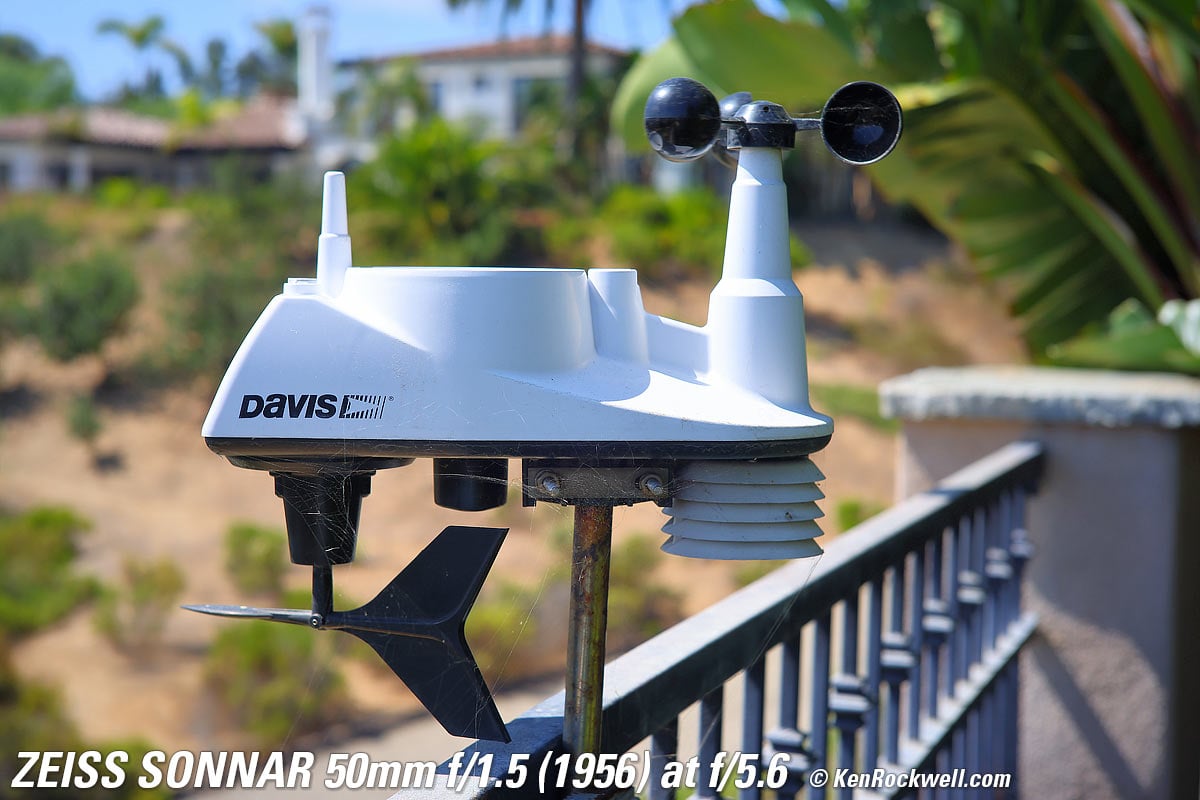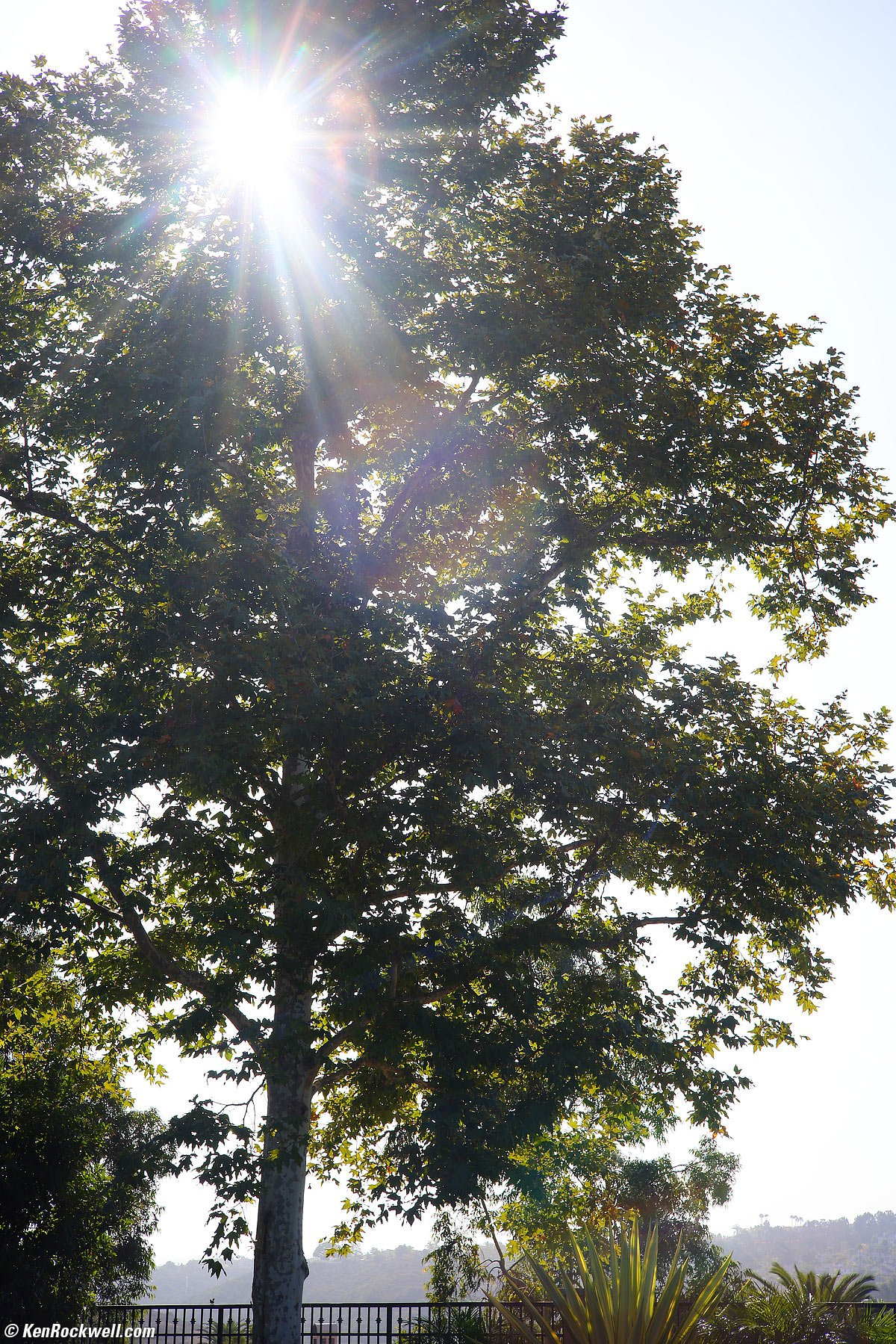Zeiss Sonnar 50mm f/1.5
(1937‑1962)
For CONTAX Rangefinder cameras
Adapts to all mirrorless cameras
See also the modern Zeiss ZM 50mm f/1.5 Sonnar (2004-today)
Compatibility & Usage Specifications
Zeiss Sonnar 50mm f/1.5 (this sample from 1956, 40.5mm filters, 5.4 oz./154g, about $250 used) on Canon EOS R5 using a CONTAX to LEICA M adapter and then a LEICA M to EOS R adapters. bigger. I'd get mine used at eBay (How to Win at eBay).
This all-content, junk-free website's biggest source of support is when you use those or any of these links to approved sources when you get anything, regardless of the country in which you live. Thanks for helping me help you! Ken.
October 2020 Better Pictures Zeiss CONTAX LEICA Canon Sony Nikon Nikon Rangefinder Fuji All Reviews
ZEISS SONNAR 50mm f/1.5. bigger. |
ZEISS SONNAR 50mm f/1.5. bigger. |
ZEISS SONNAR 50mm f/1.5. bigger. |
ZEISS SONNAR 50mm f/1.5. bigger. |
Sample Images top
Compatibility & Usage Specifications
More samples at Bokeh and Flare & Ghosts.
These are just snapshots and there are many more throughout the review; my real work is in my Gallery.
These are all shot as JPGs; no RAW CR3 files were used or needed.
| Canary Palm, 9:39 PM, 19 September 2020. ZEISS SONNAR 50mm f/1.5 (1956), Canon EOS R5 at f/1.5 for 2.5 seconds at ISO 100, Perfectly Clear. bigger, full resolution or camera-original © JPG file. |
Canary Palm, 9:44 PM, 19 September 2020. ZEISS SONNAR 50mm f/1.5 (1956), Canon EOS R5 at f/8 for 20 seconds at ISO 200, Perfectly Clear. bigger, full resolution or camera-original © JPG file. |
| Canary Palm, 9:26 AM, 20 September 2020. ZEISS SONNAR 50mm f/1.5 (1956), Canon EOS R5 at f/1.5 at 1/4,000 at ISO 50, Perfectly Clear. bigger, full resolution or camera-original © JPG file. | Canary Palm, 9:29 AM, 20 September 2020. ZEISS SONNAR 50mm f/1.5 (1956), Canon EOS R5 at f/11 at 1/80 at ISO 50, Perfectly Clear. bigger, full resolution or camera-original © JPG file. |
Introduction top
Compatibility & Usage Specifications
|
I buy only from these approved sources. I can't vouch for ads below. |
This is a golfball-sized classic rangefinder lens by ZEISS for the CONTAX rangefinder cameras of the 1930s through 1960s. By modern standards it's very soft away from the center at f/1.5, and gets sharp as stopped down. It's usually pretty sharp in the center, even at f/1.5.
It's easy to enlarge this image way too much as shot here on a 45MP Canon EOS R5. It's important to put the sharpness in perspective: by f/4, it easily makes super-sharp 36 × 55" (1 × 1.5 meter) prints.
This f/1.5 SONNAR replaced 1931's f/2 SONNAR in 1937, and was made until CONTAX gave up on rangefinder cameras in 1962 as SLRs took over.
The earliest lenses were uncoated and marked Carl Zeiss. After WWII they became coated and were either marked Carl Zeiss Jena (East German factory) or Zeiss Opton (West German factory). By about 1953 a trademark dispute was settled and the West German ones are simply marked "Carl Zeiss" again, as seen here in my 1956 sample.
This lens has no ability to focus on its own. The focus mechanism is built into CONTAX and Nikon Rangefinder cameras or in your adapter, which is why adapters are so expensive.
Zeiss also sells this same timeless optical design brand-new today for the LEICA M mount as the Zeiss ZM 50mm f/1.5 Sonnar. You can use this on all mirrorless with a LEICA M adapter.
I'd get my ZEISS 50mm f/1.5 used at eBay (How to Win at eBay).
New intro top
 World's first 50mm f/1.5 lens in 1937.
World's first 50mm f/1.5 lens in 1937.
Good intro top
 All-metal and glass construction.
All-metal and glass construction.
 Reasonably low distortion.
Reasonably low distortion.
 Adapts to any mirrorless camera.
Adapts to any mirrorless camera.
 MADE IN GERMANY.
MADE IN GERMANY.
Bad intro top
 Ancient lens, so most you'll find are pretty beat up, like this one after all these years — but they work fine.
Ancient lens, so most you'll find are pretty beat up, like this one after all these years — but they work fine.
 Aperture ring is on the body of the lens, but since the whole lens body rotates to focus, it's difficult to change the aperture without changing the focus.
Aperture ring is on the body of the lens, but since the whole lens body rotates to focus, it's difficult to change the aperture without changing the focus.
Missing intro top
 No focus helicoid; that's in your rangefinder camera or adapter.
No focus helicoid; that's in your rangefinder camera or adapter.
 No auto focus.
No auto focus.
 No Image Stabilization, although it works great with in-body sensor-shift stabilization.
No Image Stabilization, although it works great with in-body sensor-shift stabilization.
 No automatic diaphragm; you have to open and close it yourself.
No automatic diaphragm; you have to open and close it yourself.
Compatibility & Usage top
Compatibility & Usage Specifications
I'd get my ZEISS 50mm f/1.5 used at eBay (How to Win at eBay).
This lens is intended for CONTAX' rangefinder cameras made from the 1930s through the 1960s. Very few were sold in other mounts.
Its also mounts on Nikon's Rangefinder cameras (1940s - 1960s), but since its actual focal length (53.2mm) differs from Nikon's actual 50mm focal length, rangefinder focus becomes increasingly incorrect as focused more closely. It's fine at and near infinity.
Today it's trivial to adapt this to any rangefinder camera. Just as it's difficult to get direct flights from a small town to a major city and one often has to take connecting flights, the easiest way to adapt this lens to mirrorless is to connect through the very popular LEICA mount.
Get a Contax to LEICA adapter, and then a LEICA to your brand of camera adapter. This is because there are lots of adapters from CONTAX to LEICA, and loads of adapters from LEICA to every other brand, but few adapters from CONTAX directly to mirrorless. Pay close attention: LEICA uses two different mounts, screw (a.k.a. L39 or LTM, made 1920s - 1960s), and today's M bayonet mount (1953-today). You can get adapters to and from either LEICA mount; I'd suggest going CONTAX to LEICA M and then LEICA M to your camera, but either works so long as both adapters use the same kind of LEICA mount.
This lens does not work with any of the CONTAX G System (1994 ~ c.2004), which uses a completely different mount. I don't know of any easy way to adapt this lens to the CONTAX G System.
Specifications top
Compatibility & Usage Specifications
I'd get my ZEISS 50mm f/1.5 used at eBay (How to Win at eBay).
Name specifications top
ZEISS call this the SONNAR 50mm f/1.5.
Optics specifications top
ZEISS SONNAR 50mm f/1.5 internal optical construction.
7 elements in 3 groups.
What looks like white and blue glass is all just glass; this diagram uses these colors to let us see the two groups of three cemented elements more clearly.
The complex groups of three cemented elements are used to eliminate air-to-glass surfaces, which in the days before lens coatings (before WWII) were critical to increasing light transmission, lowering flare and ghosting and increasing contrast.
Filters specifications top
Brass 40.5 × 0.5mm filter thread.
Diaphragm specifications top
The weird clouds around the outside of the glass seen at f/2.8, f/5.6 and f/11 are lens element separation. It looks horrible here, but the lens works fine with it.
At f/1.5. bigger. |
At f/2.8. bigger. |
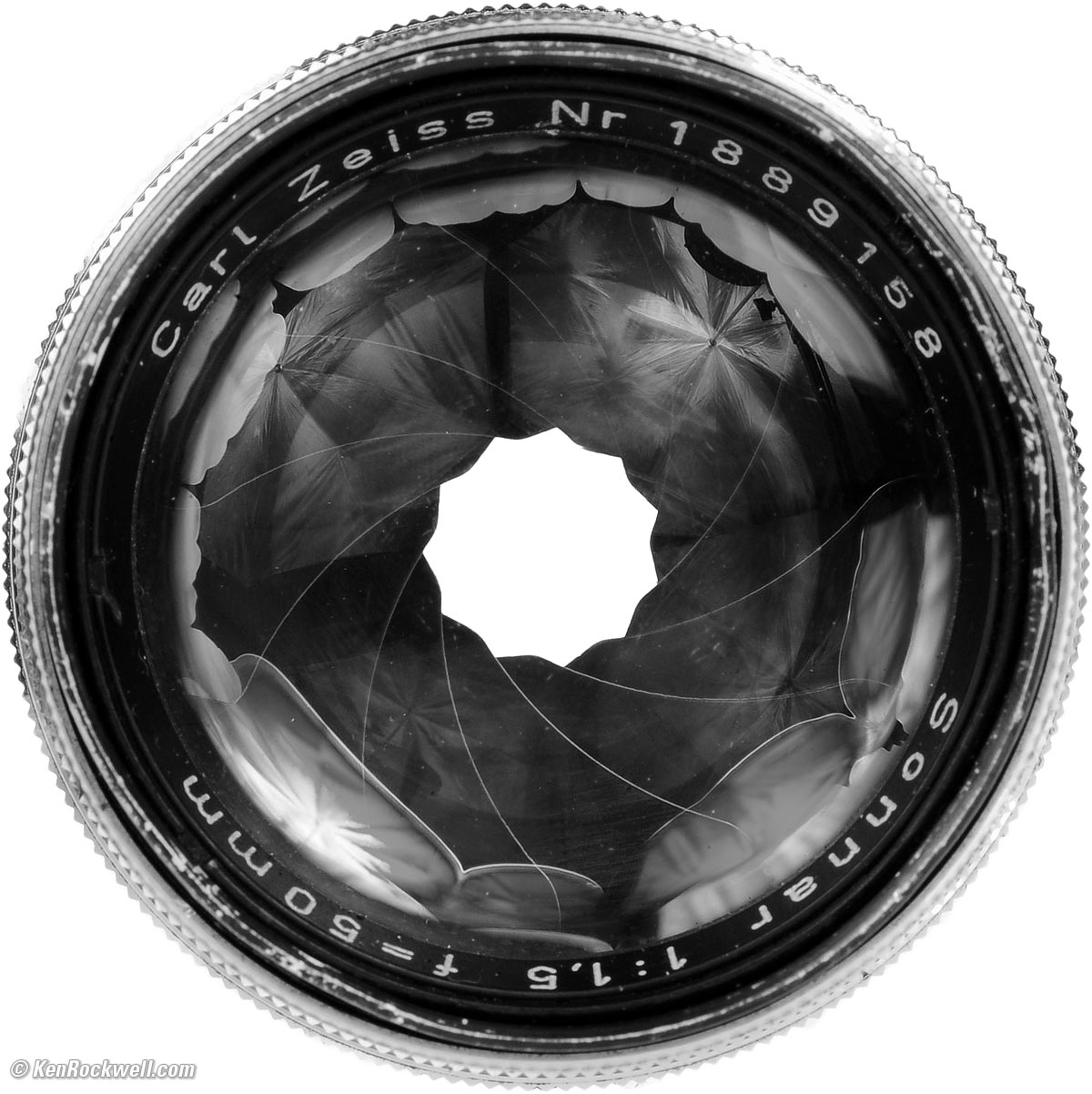 |
|
At f/5.6. bigger. |
At f/11. bigger. |
11 blades.
Stops down to f/16 with no click stops.
Focal Length specifications top
53.2mm.
When used on an APS-C camera, it sees the same angle of view as an 80 mm lens sees when used on a full-frame or 35mm camera.
See also Crop Factor.
Angle of View specifications top
44¼º diagonal on full-frame.
Focus Scale specifications top
Not on lens, but often on adapter or camera's focus mount.
Infinity Focus Stop specifications top
Yes, on camera.
Depth of Field Scale specifications top
Not on lens, but often displayed on camera's focus mount.
Infrared Focus Index specifications top
No.
Close Focus specifications top
Depends on camera or adapter.
Caps specifications top
It uses ordinary 40.5mm front caps.
The rear caps are specialized.
Hood specifications top
There were and are dedicated 40.5mm screw-in hoods available. (How to Win at eBay.)
Size specifications top
1.81" ø maximum diameter × 1.65" long overall.
46 mm ø maximum diameter × 42 mm long overall.
Weight specifications top
5.445 oz. (154.4 g) actual measured weight.
Quality specifications top
MADE IN GERMANY.
Announced specifications top
1937.
Discontinued specifications top
1962.
Price, U. S. A. specifications top
September 2020
About $250 used if you know How to Win at eBay.
Performance top
Compatibility & Usage Specifications
Overall Breathing Bokeh Coma Distortion
Ergonomics Exposure Falloff Filters
Flare & Ghosts Lateral Color Fringes
Sharpness Stabilization Sunstars
I'd get my ZEISS 50mm f/1.5 used at eBay (How to Win at eBay).
Overall performance top
The 50/1.5 is soft at f/1.5, and sharpens up as stopped down.
Wide-open it's reasonably sharp in the center and very soft as you get to the sides, and pretty sharp all over by f/4.
Focus Breathing performance top
Focus breathing is the image changing size as focused in and out. It's important to cinematographers that the image not breathe because it looks funny if the image changes size as focus gets pulled back and forth between actors. If the lens does this, the image "breathes" by growing and contracting slightly as the dialog goes back and forth.
As a unit-focus lens, the image gets larger as focused more closely.
Bokeh performance top
Bokeh, the feel, character or quality of out-of-focus areas as opposed to how far out of focus they are, is weird and a bit rough wide-open (as we expect from 1930s designs), and becomes beautifully smooth as stopped down.
Here are photos from headshot distance. Click any for the © camera-original files:
Made-in-U. S. A. Davis 6250 weather station, 20 September 2020. Click any for the camera-original © JPG files. Shot with Canon EOS R5 at 1/4,000, 1/1,600 and 1/400 at ISO 100, Perfectly Clear.
As always, if you want to throw the background as far out of focus as possible, shoot at f/1.5 and get as close as you can.
Coma performance top
Coma, or sagittal coma flare, is often seen with fast normal to wide lenses as weird batwing shapes on bright points of light in the corners at night.
It has a lot at f/1.5. It's mostly gone at f/2 and all gone by f/2.8.
Distortion performance top
The is a moderately small amount of pincushion distortion.
It's easy-to-correct with a factor of -1.85 in Photoshop's lens correction filter.
Ergonomics performance top
ZEISS SONNAR 50mm f/1.5. bigger. |
ZEISS SONNAR 50mm f/1.5. bigger. |
It's a small, dense lens. The back half disappears into the mount, leaving only the focus and aperture rings exposed.
Assuming you know your gear, it's easy to mount and unmount with your eyes closed. There is a protrusion on the mount with a red dot which serves as a mounting index.
Once mounted, the larger ring becomes focus, which twists the lens in the camera's or adapter's own focus helicoids.
The aperture ring is a pain. It's easy to turn, but you have to use your other hand to hold the lens so it doesn't turn while you turn the aperture ring.
Exposure performance top
On my Canon EOS R5, as is typical on other cameras, often the finder may look correctly exposed while the final images are grossly overexposed at large apertures in daylight. On my Canon EOS R5, it warns us by blinking the EXP SIM (exposure simulation) icon in the finder. In these cases I revert to manual exposure and trial-and-error. This happens if the shutter speed needs to go above about 1/500.
Night photography is just fine. The night shots at the top were made with auto exposure and the camera took care of everything.
Falloff performance top
Falloff is visible at f/1.5, and goes away at smaller apertures.
I've greatly exaggerated the falloff by shooting a gray field and placing these on a gray background; it will not look this bad in actual photos of real things:
Falloff on full-frame infinity, no correction.
© 2020 KenRockwell.com. All rights reserved. |
Filters, use with performance top
Use standard 40.5mm x 0.5mm thread pitch filters.
Flare & Ghosts performance top
Even my old, slightly foggy and edge-separated sample has lots of contrast and few if any ghosts.
This lens was designed in the days before coatings, so it keeps the air-glass surfaces to an absolute minimum. This means that even with the potential for internal haze and delamination in old lenses like mine that there are few if any ghosts:
Tree, 9:18 AM, 20 September 2020. ZEISS SONNAR 50mm f/1.5 (1956), Canon EOS R5 at f/11 at 1/100 at ISO 100, exactly as shot. bigger or camera-original © JPG file.
Lateral Color Fringes performance top
As you can see above, there are few to no lateral color fringes. This is excellent.
Lens Corrections performance top
No camera corrects anything about this lens.
There are no lens profiles for it and no electronic communication between it and the camera.
Mechanical Quality performance top
ZEISS SONNAR 50mm f/1.5. bigger. |
ZEISS SONNAR 50mm f/1.5. bigger. |
There are no better-made lenses. This German-made super-model is all metal and glass, and nothing but.
This tiny lens weighs more (5.4 oz./154g) than the much larger, but all-plastic, Canon EF 50mm f/1.8 II (4.3 oz./122g).
Sharpness performance top
Lens sharpness has nothing to do with picture sharpness; every lens made in the past 100 years is more than sharp enough to make super-sharp pictures if you know what you're doing. The only limitation to picture sharpness is your skill as a photographer. It's the least talented who spend the most time worrying about lens sharpness and blame crummy pictures on their equipment rather than themselves. Skilled photographers make great images with whatever camera is in their hands; I've made some of my best images of all time with an irreparably broken camera! Most pixels are thrown away before you see them, but camera makers don't want you to know that.
If you're not getting ultra-sharp pictures with this, be sure not to shoot at f/11 or smaller where all lenses are softer due to diffraction, always shoot at ISO 100 or below because cameras become softer at ISO 200 and above, avoid shooting across long distances over land which can lead to atmospheric heat shimmer, be sure everything is in perfect focus, set your camera's sharpening as you want it (I set mine to the maximum) and be sure nothing is moving, either camera or subject. If you want to ensure a soft image with any lens, shoot at f/16 at ISO 1,600 at default sharpening in daylight of subjects at differing distances in the same image.
This said, it's softest at f/1.5 and softest in the corners. Stop down, and by f/4 it's very sharp, and gets sharper in the corners as topped down.
Image Stabilization performance top
This lens has no Optical Image Stabilization (OIS, IS or VR (Vibration Reduction)), but your camera may.
"Percent Perfectly Sharp Shots" are the percentage of frames with 100% perfect tripod-equivalent sharpness I get when I'm shooting hand-held while free-standing with no support or bracing. Hand tremor is a random occurrence, so at marginal speeds some frames will be perfectly sharp while others will be in various stages of blur — all at the same shutter speed. This rates what percentage of shots are perfectly sharp, not how sharp are all the frames:
| % Perfectly Sharp Shots on Canon EOS R5 | 1 |
1/2 |
1/4 |
1/8 |
1/15 |
1/30 |
1/60 |
1/125 |
1/250 |
| Stabilization ON | 0 |
10 |
10 |
33 |
83 |
100 |
100 |
100 |
100 |
| Stabilization OFF | 0 |
0 |
0 |
0 |
33 |
33 |
50 |
83 |
100 |
I see about a two- to three-stop real-world improvement.
Sunstars performance top
With an 11-bladed diaphragm that's every shape other than an polygon and is different at every setting, I get different kinds of sunstars at every aperture.
Ultimately, I can't get much in the way of a regular sunstar from this lens at any setting.
Recommendations top
Compatibility & Usage Specifications
I'd get my ZEISS 50mm f/1.5 used at eBay (How to Win at eBay).
If your work demands MADE IN GERMANY quality and a classic look, this is one of many options. Zeiss also sells this same timeless optical design, made in Japan brand-new today for the LEICA M mount as the Zeiss ZM 50mm f/1.5 Sonnar. You can use this on all mirrorless with a LEICA M adapter.
This lens isn't as sharp as modern lenses if you're working in a lab, but great pictures don't come from labs. It was extremely popular for decades, and works swell on today's hot cameras with the right adapters, and has no problem producing sharp results for huge prints. The people who love these lenses love them precisely because of the character they impart to their images.
I use a clear (UV) protective filter instead of a cap so I'm always ready to shoot instantly. I only use a cap when I throw this in a bag with other gear without padding — which is never. The UV filter never gets in the way, and never gets lost, either.
The Hoya HD 40.5mm UV filter is the very best. It's made of hardened glass, multicoated, and additionally coated to resist dirt and fingerprints. It's usually very expensive in larger sizes, but for 40.5mm not more expensive than the much other regular filters, so just get it and live it up.
All these filters are just as sharp and take the same pictures, the difference is how much abuse they'll take and stay clean and stay in one piece.
I'd get my ZEISS 50mm f/1.5 used at eBay (How to Win at eBay).
This 100% all-content website's biggest source of support is when you use those or any of these links to approved sources when you get anything, regardless of the country in which you live. xx does not seal its boxes in any way, so never buy at retail or any other source not on my personally approved list since you'll have no way of knowing if you're missing accessories, getting a defective, damaged, returned, non-USA, store demo or used xx. I use the stores I do because they ship from secure remote warehouses where no one gets to touch your new camera before you do. Buy only from the approved sources I use myself for the best prices, service, return policies and selection.
Thanks for helping me help you!
Ken, Mrs. Rockwell, Ryan and Katie.
© Ken Rockwell. All rights reserved. Tous droits réservés. Alle Rechte vorbehalten. Ken Rockwell® is a registered trademark.
Help Me Help You
I support my growing family through this website, as crazy as it might seem.
The biggest help is when you use any of these links when you get anything. It costs you nothing, and is this site's, and thus my family's, biggest source of support. These places always have the best prices and service, which is why I've used them since before this website existed. I recommend them all personally.
If you find this page as helpful as a book you might have had to buy or a workshop you may have had to take, feel free to help me continue helping everyone.
If you've gotten your gear through one of my links or helped otherwise, you're family. It's great people like you who allow me to keep adding to this site full-time. Thanks!
If you haven't helped yet, please do, and consider helping me with a gift of $5.00.
As this page is copyrighted and formally registered, it is unlawful to make copies, especially in the form of printouts for personal use. If you wish to make a printout for personal use, you are granted one-time permission only if you PayPal me $5.00 per printout or part thereof. Thank you!
Thanks for reading!
Mr. & Mrs. Ken Rockwell, Ryan and Katie.
